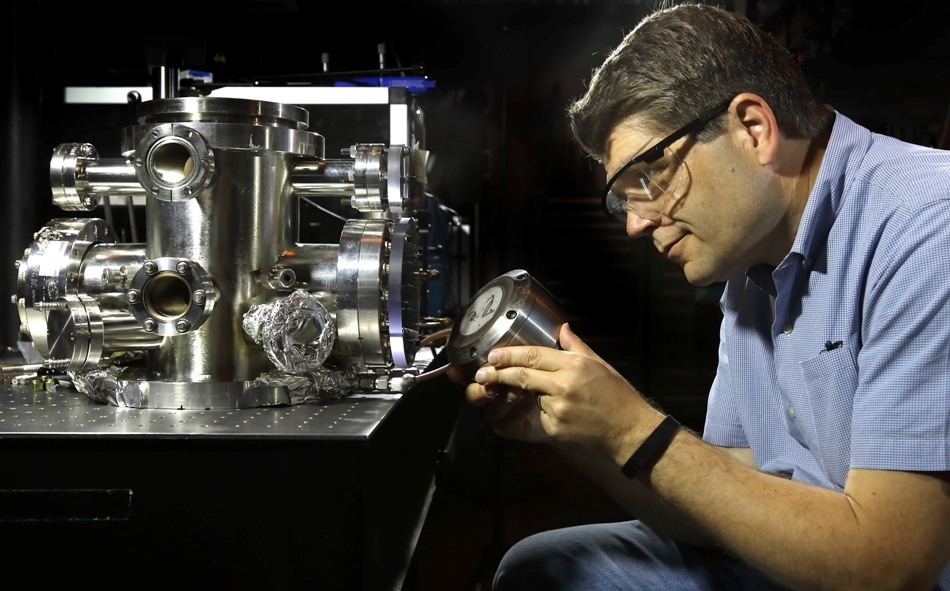Jun 11 2019
A study led by Sandia National Laboratories has revealed new insights regarding how to understand and finally control the chemistry of ignition behavior and pollutant development. The finding will ultimately lead to cleaner, more capable internal combustion engines.
 Sandia National Laboratories researcher Nils Hansen, shown here assembling equipment in the Combustion Research Facility, says new insights on how to control the chemistry of ignition behavior and pollutant formation will lead to the design of new fuels and improved combustion strategies. (Photo by Dino Vournas)
Sandia National Laboratories researcher Nils Hansen, shown here assembling equipment in the Combustion Research Facility, says new insights on how to control the chemistry of ignition behavior and pollutant formation will lead to the design of new fuels and improved combustion strategies. (Photo by Dino Vournas)
“Our findings will allow the design of new fuels and improved combustion strategies,” said Nils Hansen, Sandia researcher and lead author of the research. “Making combustion cleaner and more efficient will have a huge impact, reducing energy use around the globe.”
The research, which concentrates on the chemical science of low-pressure flame measurements, is presented in the Proceedings of the Combustion Institute and was chosen as a distinguished paper in Reaction Kinetics for the 37th International Symposium on Combustion. Authors include Hansen, Xiaoyu He, former Sandia intern Rachel Griggs and former Sandia postdoctoral appointee Kai Moshammer, who is currently at the Physikalisch-Technische Bundesanstalt in Germany. The study was sponsored by the Department of Energy’s Office of Science.
Creating a massive dataset of flames and fuels
The team integrated the output from carefully regulated measurements on an extensive range of fuels into a single categorized and annotated dataset. Correlations among the 55 separate flames involving 30 different fuels were then used to decrease ambiguity, identify unpredictable data, and disentangle the effects of the fuel structure on chemical combustions pathways that result in harmful pollutants. A preliminary analysis looked into relationships among peak concentrations of chemical intermediates that play a role in molecular weight growth and subsequent soot formation.
Hansen said that, to his knowledge, this is the first time that scientists have studied these possibilities. By identifying discrepancies, the new techniques eventually should pave the way to better models for comprehending combustion. Normally, well-regulated experiments help corroborate computer models to comprehend the combustion process and to form new combustion strategies.
Data from low-pressure premixed flames is usually used to confirm chemical kinetic mechanisms in combustion. These comprehensive mechanisms then offer the foundation for understanding the creation of pollutants and predicting behavior for combustion applications.
Historically, research papers stated data from a single flame or a few flames, together with one new mechanism for a particular fuel. However, the method established by Hansen’s team guides the way for measuring a large sum of flames and publishing many mechanisms that are not typically cross-validated with other data and mechanisms.
Hansen compares the finding to the excavation of an old artifact. Only limited conclusions can be gotten from a single artifact. However, putting together numerous similar artifacts forms a fuller historical picture.
Our work reveals information typically hidden in the ensemble of low-pressure flame data. For example, useful targets for model validation can be gleaned from a database with more than 30,000 data points.
Nils Hansen, Researcher and Study Lead Author, Sandia National Laboratories
Analyzing flames
After examining the flames, scientists learned that correlated properties offer new validation targets accessible only when investigating the chemical structures of a broad set of low-pressure flames.
Hansen said the wide-ranging chemical-kinetic models for combustion systems progressively are used as the foundation for engineering models that forecast fuel performance and emissions for combustor design. These models are frequently unclear due to the large set of parameters used to inform the model, but synchrotron-based, single-photon ionization mass spectrometry measurement, initiated in DOE’s Gas Phase Chemical Physics program, has produced an unprecedented surge of comprehensive chemical data.
Long-term benefits
The study ultimately will help to put together more accurate chemical mechanisms for defining combustion processes, Hansen said.
“Our goal is to better understand and ultimately control the chemistry of ignition behavior and pollutant formation,” he said. “Subsequently, this will lead to clean and efficient internal combustion engines.”
Hansen said that his team’s conclusions reveal a completely new path for research at Sandia’s Combustion Research Facility.
Applying data science and machine-learning tools extracts even more information from large datasets. Our work has opened the gate wide to show that data science can be applied to combustion research.
Nils Hansen, Researcher and Study Lead Author, Sandia National Laboratories